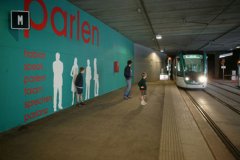This case's main initiator is TRAM, a transport operator in Catalonia. TRAM differentiate between graffiti on fixed facilities and vehicles and apply different strategies. Furthermore, there are distinct strategies implemented on fixed facilities according to their location: over ground or under ground (inside tunnels). For the over ground stops only anti-graffiti coating applied. The strategy implemented in stops under tunnels was more complex. Four stops where inside tunnels three in the northern-east part of the city and one in the south-wedtern area. The first intervention was done in 2004 and the other three during 2007 sfter the success in graffiti prevention of the previous experience. TRAM foresaw graffiti could be written on their facilities so they requested University of Barcelona’s Fine Art Faculty to develop a project on underground stops in both TRAMBAIX and TRAMBESOS. From the stakeholder’s point of view those kinds of stops were a pull factor for graffiti as there were big blank walls and its free access.
The intervention consisted of a prevention intervention of graffiti by painting the walls and creating several artistic expressions like phrases and objects with a visual impact.
The intervention was visual and symbolic, also providing a transit space with identity, to which people could feel identified with. From a pro-social approach the intervention took place in order to eradicate tag although promoting street art, which is a main trait of the second cluster cases. As well, it has an environmental scope which aims at providing a certain space with attributes that can prevent graffiti.
The artists in charge of the project decided to reconceptualise the space. For them, these spaces can have a poetic impact on the users’ daily life. In the artists’ words “We emphasized the spaces’ character” meaning that if a concrete space has a function, this can be poetized. Moreover, spaces’ function should be poetized in order to achieve spaces’ coherence. This is an example of pro-social interventions with a constructive approach, where the significance of a certain place exalts it’s utility to articulate a function and a new, deeper significance.
Thus to achieve the spaces’ reconceptualization the artists wanted to highlight that place was a traffic space which occurred all over the world, representing not only a collective identity but also an individual one. Several phrases were written on the walls, for example “Every day I see you come back” in reference to that common experience that is seeing frequently someone in the transport. Also “Silences speak” or “change is permanent” contradictions that for the artists create an internal order. For the artists it’s not only the fact that now stations look like a “huge graffiti” or an street art piece what has led to effectiveness in graffiti prevention but the reinforcement of the space’s identity. Furthermore, thinking of the space as a whole.
Apart from the artistic intervention TRAM used anti-graffiti paint. They have had very few graffiti although the stakeholder highlights that if graffiti are rapidly cleaned it’s very difficult to attract more. There hasn’t been any change for 10 years.

